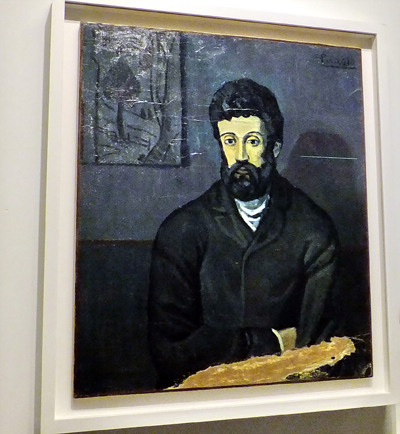|
 |
|
ONE PORTRAIT: A portrait work created by Picasso during his blue period is on show at the China Pavilion in Shanghai (NEWSPHOTO) |
However, visitors without training in art appreciation will find it hard to perceive the meaning of many non-realistic works, as Picasso was a master of different styles. Picasso changed his style through his 80-year-long and prolific career, such as the blue and rose period dominated by early realistic works, the African period, Cubism, Classicism and Surrealism.
Picasso's early paintings (1901-04) of the blue period, in which blue dominates the color schemes, deal with outcasts, beggars, sick children, and circus people. The Old Guitarist is the most famous of his blue period paintings. In Paris, Picasso developed his rose period (1905-06) style with a lighter palette, which is exemplified in The Boy With Horse.
And realistic works, which are easy for the audience to comprehend, only account for 10 percent of the whole exhibition. Puzzled though, most visitors enjoy standing before many Cubist works and observe them carefully to catch what Picasso wanted to express.
Picasso developed Cubism between 1907 and 1921.The oil painting Les Demoiselles d'Avignon created in 1907, regarded as the world's first Cubist work, is also on show in Shanghai.
"Through these avant-garde innovations, Picasso selected, interpreted and represented the natural scenery, human society and events, which made him the most revolutionary, the most prodigious artist in the history of modern Western art," said Taiwan contemporary poet, writer and critic Yu Guangzhong.
Although Picasso's influence was palpable in works of many active Chinese artists in 1920s and 1930s, he and his Cubist works were formally introduced to China, along with other Western artists, after the country adopted the reform and opening-up policy in the 1980s.
"Thoughts and trends changed so fast in China after 1980s, that's why we think Picasso had greater influence on Chinese painters in 1920s and 1930s, when Cubism and Expressionism reached its peak in Europe," said artist Yin Zhong.
But the opening up allowed China's fine arts circles to absorb nutrition from diverse styles other than realism. Picasso was first introduced to China in 1983, in memory of 10th anniversary of his death. A special report on The Messenger, a publication by People's Press, took Yin and many of his contemporaries into the artistic world of Picasso.
Chen Jianjun, who started to learn oil painting in 1984 at the Nanjing University of the Arts, said, all of his classmates were more or less influenced by Picasso, and almost every artist at that time owned an album of his paintings.
"Paintings are no longer an abstract ideal of physical beauty or a poetic representation of visual images—Traditional Chinese painters find it difficult to accept the three-dimensional representation of Cubism," said Chen.
But "Picasso's influence on Chinese art is mainly theoretical, as it's too difficult to create new beauty through exaggerated deformation," said Yin. "Chinese painters have their own aesthetics."
Art education in institutes still focuses on sketch and realistic painting skills although Picasso, Cubism and Surrealism are recognized among artists, Yin said.
"The most important thing about Picasso is the constant self-negation, which is the value of modernity," said Jiang Chongwu, a Chinese contemporary painter. "Chinese artists are not brave enough to negate and change themselves."
Picasso was also influenced by Chinese art. He once said, "Had I been born Chinese, I would have been a calligrapher, not a painter." Chinese calligraphy style is visible in his paintings, making images in his paintings more abstract and condensed compared with images created by other Western painters.
Brush calligraphy is not only loved and practiced by the Chinese, Korean, and Japanese as an important treasure in their heritage. It is equally adored by Westerners.
Picasso and Henri Matisse were the two Western artists who openly declared the influence of Chinese calligraphy on their works. Traces of calligraphy strokes are visible in the paintings of Matisse. | 